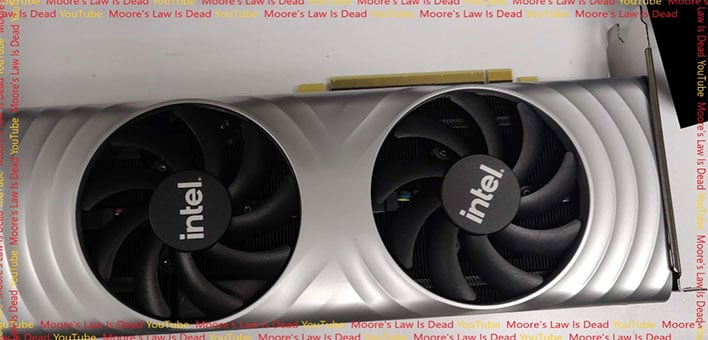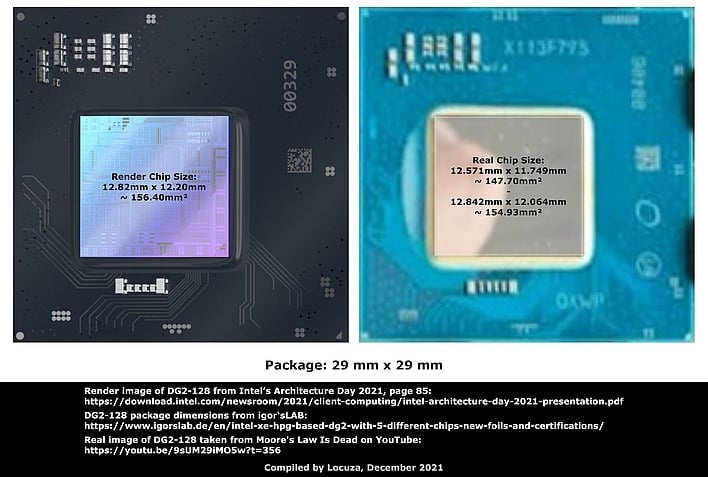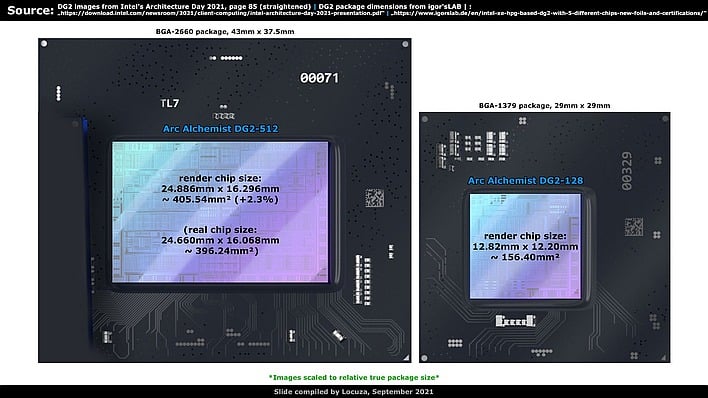Leak Compares Alleged Flagship Intel Arc GPU Die Size To NVIDIA Ampere, How It Stacks Up
We've seen a lot of reactions to Intel's upcoming Arc GPUs among hardware enthusiasts. Obviously, you have your die-hard Intel fans who think Arc will be a "first strike is deadly"-style attack on the GPU market. On the flip side of things, we've also seen a few folks who care so little they probably won't even read this news post. On balance, most hardware enthusiasts seem to be taking a reasonable "wait and see" approach, perhaps peppered with some cautious optimism.
Whether you've got a vested interest or just latent curiosity about Intel's upcoming discrete GPU line, check out these latest leaks. A video from hardware industry analysis YouTube channel Moore's Law is Dead—who previously provided the image above, purportedly a photo of a pre-release Alchemist product—offered what is reportedly a real image of the Alchemist DG2-128 GPU.
Well, fellow leakster @Locuza on Twitter took that picture and made a comparison (above) with Intel's previously-released renders of the DG2-128 package to come up with a real die area somewhere in the range of 147.7 to 154.9 mm². Even the largest value is smaller than Intel's render, but given that both images have been warped and modified to make this comparison, it's within the margin of error. That die area, if correct, would make the DG2-128 GPU smaller than anything NVIDIA or AMD have released this generation—though it's not far off the size (158 mm²) of AMD's Navi 14 GPU used in the RX 5500 XT.
DG2-128 is the smaller of the two known Intel Arc processors based on the Alchemist architecture. The "128" in the name comes from its supposed 128 execution units, which gives it 1,024 shader processors. The fastest cards based on that GPU are supposedly going to come in around 75 watts total board power, while equipped with 6GB of GDDR6 memory hooked up to an unusual 96-bit bus running at 16 Gbps, although there's talk of two more variants including a 4GB model with a 64-bit bus for laptops, as well as a slightly cut-down 96 EU (768 shaders) version.
The larger Alchemist GPU is the DG2-512, again named for its 512 execution units. Locuza has previously done a similar die-area comparison between Intel's render and a leaked photo, and come up with a die area of 396.24 mm². That's again just slightly smaller than indicated by Intel's render, which might lend some credibility to the claim. If accurate, that figure puts it smack in the same ballpark as the GA104 GPU used in NVIDIA's GeForce RTX 3070 Ti, RTX 3070, and RTX 3060 Ti. Considering their similar feature sets, right down to AI-specific accelerator cores and ray-tracing hardware, that data slots in nicely with the expectation that the fastest Alchemist parts should compete with Nvidia's RTX 3070.
The numbers don't necessarily line up—its 512 execution units give the DG2-512 some 4,096 shader cores, quite behind the 6,144 of a fully-enabled GA104—but it's important to recall that you really can't compare resources this way across architectures. Note that the Radeon RX 6900 XT will absolutely crush a GeForce RTX 3070 in most games, yet it "only" has 5,120 shader cores. We have no idea yet what Arc's real performance will be like, so try not to draw too many conclusions based on comparisons of this nature.
Intel has a lot to prove with this first generation of Arc GPUs. It needs to prove that it can be a credible competitor in the graphics space, but even that point has many stipulations; powerful hardware, solid software, and post-launch support are all key elements to success in this market. Beyond those queries are questions of supply and manufacturing: can Intel really make enough Arc GPUs in this shortage to make a dent in a ravenous GPU market, and will gamers actually get their hands on the hardware? Only time will tell. Intel's Alchemist GPUs launch early next year.
(Top Image Credit: Moore's Law is Dead)




